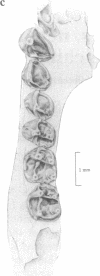Abstract
A previously unidentified middle Miocene primate from the La Venta deposits of Colombia is intermediate between squirrel monkeys (Saimiri) and callitrichines (marmosets and tamarins) in the morphology of the lower molars, mandible, and talus. Laventiana annectens is closely related to Saimiri and to Cebus (capuchin monkeys) yet resembles the probable callitrichine morphotype, demonstrating that archaic relatives of a Saimiri-like stock were suitable structural ancestors for the enigmatic callitrichines. Laventiana is also more primitive than Saimiri (= Neosaimiri) fieldsi from the same fauna, further increasing the likelihood that the latter is a lineal ancestor of modern squirrel monkeys.
Full text
PDF



Images in this article
Selected References
These references are in PubMed. This may not be the complete list of references from this article.
- Leutenegger W. Maternal-fetal weight relationships in primates. Folia Primatol (Basel) 1973;20(4):280–293. doi: 10.1159/000155580. [DOI] [PubMed] [Google Scholar]
- Setoguchi T., Rosenberger A. L. A fossil owl monkey from La Venta, Colombia. Nature. 1987 Apr 16;326(6114):692–694. doi: 10.1038/326692a0. [DOI] [PubMed] [Google Scholar]
- Sussman R. W., Kinzey W. G. The ecological role of the callitrichidae: a review. Am J Phys Anthropol. 1984 Aug;64(4):419–449. doi: 10.1002/ajpa.1330640407. [DOI] [PubMed] [Google Scholar]





